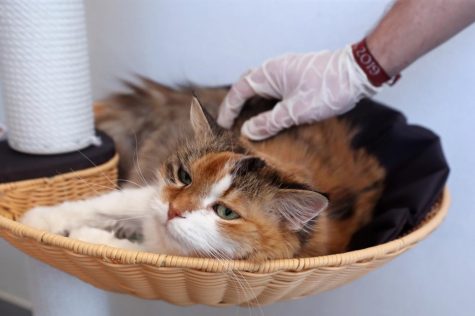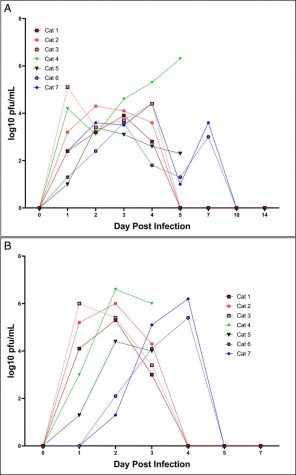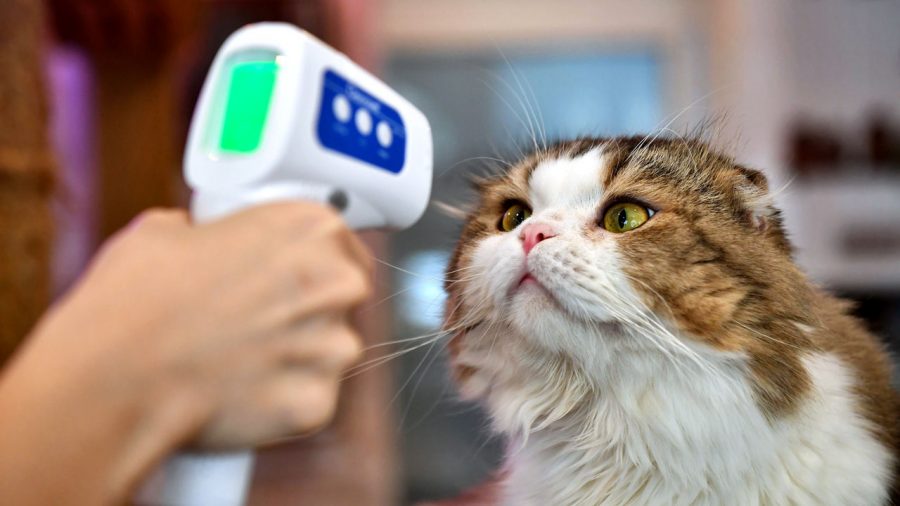Study Shows Cats can Have COVID-19
A New Study Shows Cats can Spread the Coronavirus
An employee takes a cat’s temperature at a cat café in Bangkok. LILLIAN SUWANRUMPHA/AFP VIA GETTY IMAGES
October 13, 2020
A new experiment showed that both cats and dogs can be infected with Coronavirus. Luckily, it is not probable that they will get sick. However, the study confirmed that cats can spread the virus to other cats.
In the study written by researchers of Colorado State University’s College of Veterinary Medicine and Biomedical Sciences, “domestic cats and dogs were assessed for their susceptibility to infection.” The report states, “While neither species developed clinical disease in this study, cats shed infectious virus for up to 5 [days] and infected naive cats via direct contact, while dogs do not appear to shed virus. Cats that were re-infected with SARS-CoV-2 mounted an effective immune response and did not become re-infected.” The report, published to the Proceedings of the National Academy of Sciences, states that currently there is no evidence that cats or dogs can infect humans.
To conduct the experiment, seven adult cats and three dogs were collected. The cats were from Colorado State University in a pathogen-free environment in an Association for Assessment and Accreditation of Laboratory Animal Care International accredited animal facility, and the dogs were from Ridglan Farms (Blue Mounds, WI). The animals were group-housed in the Animal Disease Laboratory at Colorado State. All animals had temperature-sensing microchips inserted, and baseline tests were run on each animal before they were introduced to the virus. All were in apparent good health at the beginning of the study.
Cats were lightly anesthetized and dogs were sedated before inoculation. “Virus diluted in phosphate buffered saline (PBS) was administered to both species via pipette into the [nasal cavities]…animals were observed until fully recovered from anesthesia,” (PNAS)
To continue the experiment, the cats were split into two groups: cat cohort 1 and cat cohort 2. When sampling from cohort 1, oral and nasal swabs were collected from “…awake or lightly anesthetized cats…” Blood was collected before inoculation and multiple other times after being infected. At 28 days post-inoculation, cats were reinoculated. Oro-nasal sample collection was performed multiple times after re-inoculation, and on days 29, 31, 33, 35, 38, and 42 post initial inoculation, cats were euthanized and tissues collected for histopathology (PNAS).

Photo Credits: REUTERS/Yves Herman © Reuters
In cat cohort 2, two of the four cats were lightly anesthetized and challenged with Coronavirus, the same as the previous group. According to the report, 48 hours post-infection, two uninfected cats were introduced into the room with the infected cats and sampled on the same days as cat cohort 1 was. The two directly infected cats were euthanized on day 5 post-inoculation, and the tissues were collected for virus isolation and histopathology. The remaining two cats were euthanized at 30 days post-inoculation and autopsies were performed (PNAS). These two cats will be referred to as contact cats.
To test the dogs, they were sampled at the same frequency and using the same methods as the cats in cohort 1 for 42 days. The dogs were not re-inoculated with the virus.
According to the study, temperatures were recorded daily for the duration of the study using thermal microchips. Cats and dogs were observed twice daily for the first 7 days post-inoculation and at least once daily for the duration of the study. Body weights were obtained weekly. “None of the animals exhibited clinical signs of disease characterized by any of these symptoms at any time during the study,” (PNAS).
The results of the study showed that “[n]one of the cats in either cohort displayed any clinical signs of disease, and all remained afebrile (temperature < 39.5 °C [103.1 °F]) throughout the study. Body weights were maintained over time. No evidence of lung involvement or any other radiographically detectable abnormalities were noted. Similarly, dogs inoculated with SARS-CoV-2 remained clinically normal and afebrile,” (PNAS).
According to the study, in cohort 1, all three cats shed the virus both orally and nasally for up to 5 days post-inoculation with peak concentration of the antibody achieved from nasal shedding on day 3. “There was some variability in titer over the course of infection that is likely attributable to sample collection (i.e., number of sneezes), but overall the data demonstrate clear presence of infectious virus in both the nasal cavity and the oropharynx for multiple days post infection,” (PNAS). Re-challenged cats in cohort 1 were sampled for oral and nasal shedding for 7 days post-exposure by viral isolation, and shedding was not detected by plaque assay in any cat at any time point following re-inoculation.

“In cohort 2, the two directly inoculated cats shed virus for 5 days post inoculation both orally and nasally, with a similar pattern to cohort 1. The contact cats, however, shed infectious virus orally by 24 hours post-exposure, and the duration of shedding was prolonged compared to the inoculated cats, with peak shedding occurring at 7 days post-exposure (Fig. 1),” (PNAS). Infectious Coronavirus was not found in the lung or other organs of either cat, and viral shedding was not detected from any of the dogs at any point post-infection.
There is no evidence of infected cats or dogs transmitting COVID-19 to humans. However, there have been several cases of pets becoming infected by COVID-19 following exposure to infected humans in New York, Hong Kong, Belgium, Germany, Spain, France, and Russia (T. H. C. Sit et al., 2020; The Brussels Times, 2020; Barrs VR, Peiris M, Tam KWS, Law PYT, Brackman CJ, To EMW, et al., 2020; M. Davidson. 2020; A Volz. 2020; N. Vlasov., 2020; S. Matthews, V. Chalmers, 2020). According to the report, in some cases such as those in “…nondomestic felids at the Bronx Zoo and pet cats in New York and Europe, animals displayed signs of respiratory disease and/or conjunctivitis. None of the cats or dogs in this study exhibited any clinical signs of disease, but individual animal health status, age, and comorbidities may be responsible for this variability,” (PNAS).
In a recent collection of serum samples of cats in Wuhan, China, including 102 sampled after the COVID-19 outbreak, and 39 prior to the outbreak. According to the survey, 14.7% of sampled cats were positive for SARS-CoV-2 “…by indirect enzyme linked immunosorbent assay (ELISA). Among the positive samples, 11 had SARS-CoV-2 neutralizing antibodies…Our data demonstrates that SARS-CoV-2 has infected cat population in Wuhan during the outbreak,” (bioRxiv). This information suggests that cats in areas with high human transmission are also probable to be exposed to the virus.
The study conducted by Colorado State University says that it is unlikely that pets are at serious risk of developing COVID-19 and they are not a significant source of infection. The article states, “Importantly, infected cats shed for no more than 5 days following exposure, suggesting that cats, if exposed to infected humans, will develop and clear infection rapidly,” (PNAS). In comparison to people, humans usually have an incubation period of about 5 days and can infect others for more than 3 weeks (S. A. Lauer et al., 2020; J. Y. Noh et al., 2020). Therefore, if individuals who have COVID-19 quarantine for 14 days with their pets, there is minimal risk of a potentially exposed cat infecting another cat or human. Furthermore, “Infected pet cats should not be allowed to roam freely outdoors to prevent potential risk of spreading infection to other outdoor cats or wildlife. More research into the susceptibility of wildlife species and potential for establishment of infection in outdoor cat populations is necessary to identify risk factors and mitigation strategies to prevent establishment of reservoir infections in feral cats or other wildlife,” (PNAS).
The cats in the study published on the Proceedings of the National Academy of Sciences’ website developed “…subclinical pathological changes in the upper respiratory tract early in the course of infection with more lower respiratory tract pathology later following viral clearance…” (PNAS). This research suggests that, while not severe enough to present definite symptoms, viral infection of cats is not completely benign and may make their utility as an animal model more relevant to mild human disease. Cat models may be extremely helpful for understanding and continuing the research of the spread of COVID-19. The study showed that cats develop “…significant neutralizing antibody titers and are resistant to reinfection, although the duration of immunity is not currently known,” (PNAS). This knowledge could prove a useful measurement for the research of vaccines for both humans and animals.
According to worldometers, as of October 8, 2020, there are 36,511,946 confirmed cases of Coronavirus worldwide.













